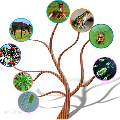We present a novel end-to-end reinforcement learning approach to automatic taxonomy induction from a set of terms. While prior methods treat the problem as a two-phase task (i.e., detecting hypernymy pairs followed by organizing these pairs into a tree-structured hierarchy), we argue that such two-phase methods may suffer from error propagation, and cannot effectively optimize metrics that capture the holistic structure of a taxonomy. In our approach, the representations of term pairs are learned using multiple sources of information and used to determine \textit{which} term to select and \textit{where} to place it on the taxonomy via a policy network. All components are trained in an end-to-end manner with cumulative rewards, measured by a holistic tree metric over the training taxonomies. Experiments on two public datasets of different domains show that our approach outperforms prior state-of-the-art taxonomy induction methods up to 19.6\% on ancestor F1.
翻译:我们提出了一套术语中自动分类学诱导的新型端到端强化学习方法。 先前的方法将这一问题作为两阶段任务( 即检测超性配对,然后将这些配对组织成树结构结构的等级结构)来对待。 我们辩称,这种两阶段方法可能会受到错误传播的影响,无法有效地优化反映分类学整体结构的衡量尺度。 在我们的方法中, 使用多种信息来源来学习术语对配对的表述方式, 并用来确定通过政策网络选择和/ textit{ 的术语。 所有组成部分都接受端到端的训练, 并获得累积的回报, 以对培训分类进行整体的树度衡量。 对不同领域的两个公共数据集的实验表明, 我们的方法超越了以前最先进的分类入门方法, 到19.6 ⁇ 祖先F1 。




